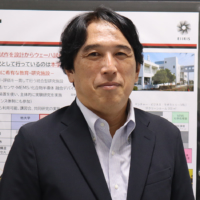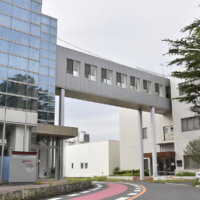Founded in 1976 in Aichi Prefecture, Toyohashi University of Technology has been a home for research on integrated circuits, the foundational component for semiconductors, since 1979.
According to the university’s charter, the mission of TUT is to “provide education and research in technological science and further technological innovation by exploring the science behind the technology.”
In further pursuit of that mission, and to leverage the university’s strengths in integrated circuit and semiconductor research, TUT in May 2023 reorganized one of its research bodies to establish the Institute for Research on Next-generation Semiconductor and Sensing Science, dubbed “IRES2.”
The goal, according to IRES2 Director Kazuaki Sawada, was to create an interdisciplinary institution where researchers working on circuits and semiconductors, as well as researchers working in such areas as agriculture, mobility and life sciences, could operate under the same roof to facilitate cross-pollination between their respective fields of study.

According to TUT interim President Akihiro Wakahara, one way in which IRES2 stands apart from other domestic research institutions is that it is equipped with a complete fabrication line for producing large-scale integrated circuits and uses the results to create semiconductors, sensing devices and so forth.
Having this on-campus LSI factory means students and researchers can work under one roof at every stage of the integrated circuit fabrication process, including not only design and processing, but also installation and evaluation, Wakahara explained.
Additionally, with the facilities to accomplish all the work present on site — including the brainstorming on the designing and processing stages as well as installation and evaluation, “They can combine the semiconductors and sensors (that they have made) into a complete package themselves,” rather than having to outsource their creations to a foundry, he said.

Sawada added: “There are several other university laboratories around Japan where they can produce transistors (for creating integrated circuits). However, one point that sets our institute apart from those institutions is that here we can make integrated circuits that have 10,000 to 100,000 transistors (LSIs). Of course, at the top level (in the commercial industry) they are making LSIs with 100 million or more, but we are the only university where 100,000-transistor circuits can be made and put to use as part of a system.”
Creating chip systems is one of the two reasons why IRES2 has such a factory on its premises in the first place. As an educational institution, it is crucial to provide opportunities to gain experience in creating systems such as semiconductors and sensor technologies that will nurture the human resources needed to further development in those areas, Sawada said.
However, the chip factory’s other purpose is to provide the opportunity to create actual semiconductor packages. Sawada, who also serves as leader of the Research Department’s Actuation and Sensing Group, offers his own work as an example.
“The institute is a laboratory that is capable of fusion research and cross-disciplinary research and development,” he said.
His team focuses on combining their ever-more-refined integrated circuits with sensors, and thanks to the IRES2 facilities they can manifest their findings into an actual “proof of concept” end product. Put another way, he said they can not only discover the fundamental technological “seeds,” but also use them to develop systems that fulfill the “needs” as well.

Fulfilling such needs is the raison d’etre for IRES2’s interdisciplinary makeup. In addition to the LSI factory, IRES2 comprises two other departments. These are the Advanced Technology Research Division, which develops cutting-edge research areas, and the Social Application and Development Department, which works up applications both for the research and the factory’s output.
The Advanced Technology Research Division includes four fields. These are innovative sensing technology creation, innovative sensing technology development, advanced environmental sensing and advanced life science.
The Social Application and Development Department, meanwhile, covers the fields of next-generation mobility society, safety and security technology, advanced agritech and human-robot symbiosis. In all of these fields, the aim is to promote collaborative, interdisciplinary research that makes use of the sensor technologies being created by the students.
Examples of projects being pursued in these departments include work being done in the Actuation and Sensing Group to develop a sensor capable of detecting some 400 scents — on par with the human nose, Sawada said — that could potentially have safety applications. Additionally, experiments being carried out in the Life Science Laboratory are looking to improve our understanding of the neural basis of sensory-driven behaviors. A project in the Future Mobility and Society Group would apply new sensor and sensing technologies to help researchers and companies plan and develop secure and safe transportation systems for the future.
“Other universities around Japan may teach students how to make integrated circuits, semiconductors and so forth, but their students do not have the chance to put what they learned into practice,” Wakahara said, referring to IRES2’s LSI factory. An additional benefit to Toyohashi students, he said, is that when they graduate and go out into the workforce, they can tell potential employers that they already have firsthand experience with the integrated circuit fabrication process and actual use of the production equipment.
IRES2 has also welcomed students from abroad for training, Sawada said. Hailing from countries such as Malaysia and South Korea, students come primarily to learn how to make semiconductors and take that experience and knowledge back to their home countries. But international interest in TUT’s offerings is not just limited to Asia. Sawada explained that a new program will be launched with the European Union that will promote exchanges of university students that will allow them to earn credits. The program will also include internships at Japanese companies and research institutions.
Furthermore, Japanese companies and the Japanese subsidiaries of foreign companies have also sent employees to receive training at IRES2. According to Wakahara, some 177 companies thus far have had their employees come to the institute to, for example, gain experience working on the fabrication line in the LSI factory.

“Here, we can create the ‘seeds’ of new technologies, and then work with companies to help them develop new products,” Sawada said. “Sensors could, for example, be combined with artificial intelligence to better analyze human health or environmental conditions.”
The hope, he added, is that through the fruits of the research performed and the training received at IRES2, researchers and students will be able to utilize both digital and analog semiconductors and sensors to innovate new technologies that can make our society healthier, safer and more sustainable for future generations.
This page is sponsored by Toyohashi University of Technology.
Toyohashi University of Technology

Address: 1-1 Hibarigaoka, Tempaku-cho, Toyohashi-shi, Aichi, 441-8580
Phone: +81-532-44-6974
E-mail: [email protected]
URL: https://www.eiiris.tut.ac.jp/en/








